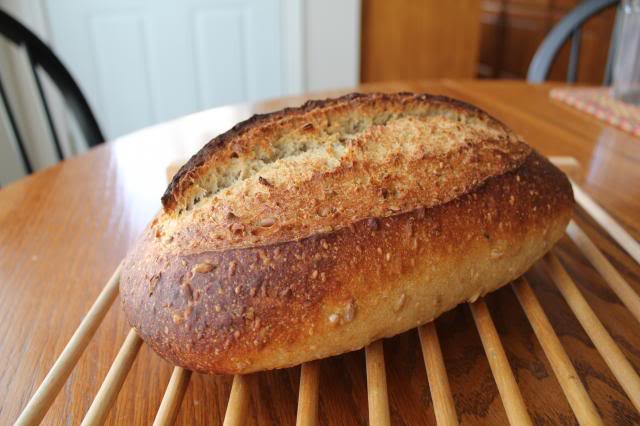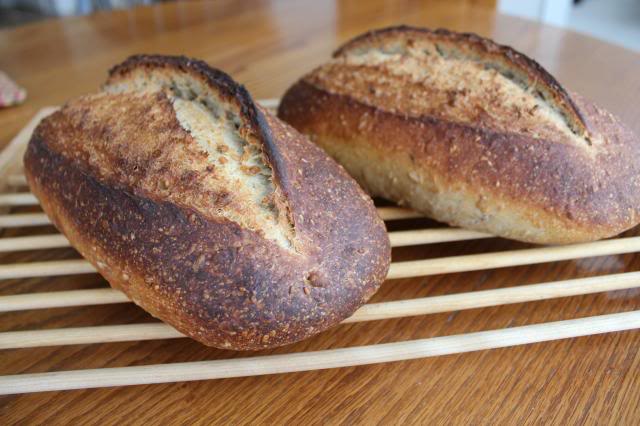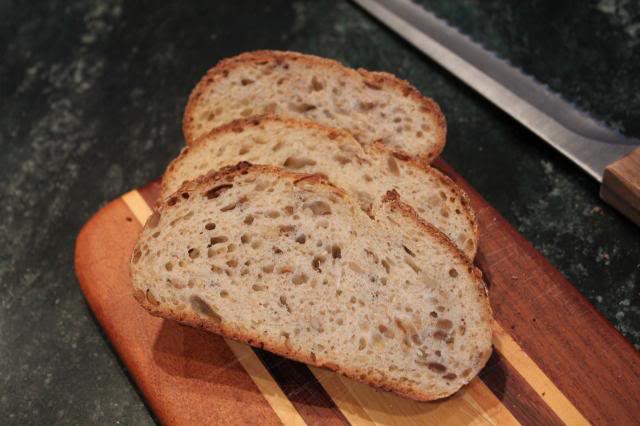
A variation on Hamelman's Sourdough Seed Bread

It was time for a break from the whole-grain breads that I have made, more often than not, in recent months. Even so, I wasn't looking for an all-white bread, either. In thumbing through the second edition of Hamelman's Bread, I came across his Sourdough Seed bread. It calls for a bit of rye flour, and a generous helping of flax, sesame, and sunflower seeds. Although there weren't any flax seeds on hand, I figured I could bluff my way through it with a bit of improvisation.
In casting about for something to substitute for the flax seed cold soaker, I came across some oatmeal that had been milled from oat groats while playing with the Kitchen Aide grain mill attachment. Okay, so oats are a cereal grain, which isn't what people usually mean when they refer to seeds. And these are ground up, not whole. Work with me, people, this is improv. So, flax seeds out, equal quantity of oat meal in. Cold water out, equal quantity of boiling water in. Now we have an oat meal scald, instead of a cold flax seed soaker.
Since my starter was at a healthy stage of development in the refrigerator, it went straight into the liquid levain with no preliminary feedings. By next morning, the levain was bubbly and ready to go. The oat meal scald was also ready, although not nearly so demonstrative, which was very much in keeping with its Scottish reserve.
Before mixing the dough, the sunflower and sesame seeds were toasted in the oven. Some stayed rather pale, others were a beautiful deep brown. After toasting, they were allowed to cool.
Per the instructions, the soaker (scald, in this case), the levain, the seeds, and the final dough ingredients were all combined and mixed. Mixing was done by hand, rather than by machine. The resulting dough at first appeared to be somewhat dry, since it required some work to get all of the flour absorbed. Once past that stage, it switched to being a rather sticky dough and stayed sticky throughout. This may have been an artifact of the oat meal scald. After mixing to a rough dough, it underwent another 8 minutes of slap and fold kneading. By the end of that workout, it was showing good gluten development.
The dough was shaped into a loose boule and placed in a plastic-covered bowl to ferment. About an hour and a quarter later, the dough was given a stretch and fold, then reshaped into a boule and returned to the bowl for roughly an hour and a half of additional fermentation. I was surprised when I uncovered the dough in preparation for shaping by the scent of peanut butter. It wasn't really that, on closer consideration, but that was how my brain first interpreted the the toasty/oily fragrance of the sunflower seeds and sesame seeds in the dough.
At the end of the bulk fermentation, the dough was divided in two. Each piece was pre-shaped, allowed to rest for a few minutes, then given a final shaping as a batard. Final proofing was in parchment couches with side support. It took nearly three hours of final proofing before the bread was ready for baking; kitchen temperatures were in the 70-72F range yesterday.
Baking was pretty much as instructed, with steam. I chose to go a few minutes longer with the bake to get a darker crust color. The bread was removed from the oven when the internal temperature was 207F.
While I would have liked additional oven spring, that may not be a reasonable expectation, given the load of the seeds and the scald. Both loaves have a lovely ear. The coloring of the grigne shows that the bread continued to expand throughout the bake. I had noticed a lot of condensation of the steam on the surface of the loaves a couple of minutes into the bake, which helped keep the crust soft and allow good expansion.
Here's another picture of the baked loaves:

The crumb, when I cut some slices for toast this morning, has a range of bubble sizes:

None are especially large, but, when you look at the seed distribution, there really isn't much they could have grown without banging into a seed of some kind. The crust was initially very hard. After 24 hours in plastic, it has softened somewhat. The crumb is very moist and cool, some of which I attribute to the oat meal scald. The flavor is definitely tilted in the direction of the toasted seeds,with plenty of nutty and toasty notes. I can't distinguish the oat meal or the rye flour as individual flavors, although I am certain that they are part of the background grainy flavors. The crust contributes hints of caramel, as well. Overall, it's a very good bread that I enjoyed toasted and expect to enjoy as the foundation for sandwiches. My thanks to Chef Hamelman for creating a bread that is still good in spite of my unanticipated variation.
Paul


Comments
inside and out, i love your improvisation with the flax out oat scald in too. Wish my apprentice was that much on the ball and not scared to change things up with he recipe needs changing. Heck, you don't even have an apprentice ... i would send you mine to gain some flexibility from you but she is afraid of her own shadow and doesn't travel well.
So what is the hydration of this loaf that it started out so dry? Love the bold bake and blistered smiley faces too!
Well done and happy baking Paul
At least from some of what you describe, anyway. It's hard to believe that someone brave enough to face down a badger would quail at the thought of changing a formula.
Hydration is 75%. I was initially mixing the dough with a large spoon, which wasn't doing a good job of incorporating the last of the flour. When I switched to squeezing the dough through my fingers, that exposed a lot more of the wetter interior and took up the remaining flour much more easily.
It did turn out to be a pretty bread, didn't it?
Paul
Great looking bake Paul. Looks like you achieved an excellent crust and perfect crumb for this kind of bread with so many seeds.
Regards
Ian
I'm pretty happy with it. When it looks good and tastes good, what else is there to ask for?
Paul
Really nice, Paul.
It didn't hurt any that I remenbered to take the pictures while it was still daylight. Nothing like natural light to make a bread look good.
Paul
Those are lovely breads ! Nice substitution. I would have had to do likewise since we don't allow flax in the house :) I like the bolder bake too. c
My wife likes flaxseed meal in things like our granola, so tends to buy that nowadays instead of the whole seeds.
I like the deeper color, too. If you look closely, it's a bit of a farmer's tan, since the lower portion of the loaf was shielded by the parchment paper and didn't brown up as much.
Paul
Beautiful grigne, Paul! A very good bread.
-Khalid
And for once I got the angle right on the cut. Et voila! A grigne to be happy with. Amazing how the little details have such a big effect.
Paul
it has that lovely pinkish color I love. It looks light and tasty.
Sorry for all that sawdust in the past months :-))
bread, Nico. This one might not make you quite so happy when it is in your mouth, since it does require some chewing. It isn't tough, mind you, just substantial.
Who said anything about sawdust?! I like my wholegrain breads. I also like variety. :-)
Paul
removing the paper and finishing the bake out of the hot pot. A bit of a juggle to do so but makes for the all over brown and not the dreaded farmer's tan :) As to flax...well I know most folks love the stuff but not to put too fine a point on it ...we don't need it LOL !
Your one slash is so nice...c
flax seed, it just passes through your digestive system completely untouched - even if soaked. Putting them whole in bread, instead of grinding, is perfect for those who don't need or want flax to contibute any nutritional value to their bread... but still want the brown bits to show up better in their crumb shots :-)
Between the seeded levain and the 5-grain levain, I think there is lots of room for improvisation. It looks like yours worked just fine.
The ears on those loaves are real standouts! Now that you have the angle, we expect to see more like them.
Happy baking!
David
Definitely big ears this time. Makes me think of a kid I knew in high school.
And now you want me to do it consistently? You're a hard man to please, Dr. Snyder, a hard man! '-)
Paul
Paul - your loaves look beautiful. The scoring, the crumb, the color, just lovely! I bet the taste equals the other qualities.
Sjadad
Yes, the taste was also very pleasing. I'm sorry that part isn't as easy to share as a photograph.
Paul
The loaves look very handsome and delicious.
Cheers,
Annie
I appreciate your comments.
Paul